In 1911 the population of Hertford was recorded as 10,3841 including 253 people (192 soldiers, 21 wives and 50 children) at the barracks in London Road and 309 people (256 girls) at Christ’s Hospital in Fore Street.
Hertford Millenary Pageant
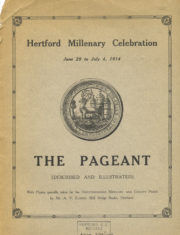
The souvenir programme for the pageant
The main talking point in 1914 especially for those who were in it was the Hertford Millenary Pageant.2 The pageant was designed to comemorate the founding of Hertford in 914 by the Saxon King, Edward the Elder.
The pageant’s effect on schools was limited. Two teachers, Walter Turpin, Master of Cowbridge School and Miss Harris, teacher at Christ Church Infants School took part in the pageant. Mr. Turpin wrote in the logbook, “June 29 to July 3. I left school early all this week at 3.30 pm. in order to take part in Hertford Pageant. Everything went on satisfactorily. Mr Howe Ed: Dept: Hertford agreed to be responsible for the closing of one class in the school.
The Christ Church logbook contains the entry, “July 3rd. Miss Harris has had permission to be absent one afternoon, and part of four afternoons this week to take part in the Pageant.”
The elder children were taken to a rehearsal in the week preceding the actual pageant whilst the younger children were either supervised by an assistant or were given the afternoon off.
On Monday morning, 3rd July the Bengeo Infant children assembled at 8.30 & 40 of the eldest children attended a Children’s Thanksgiving service in the Hertford Castle grounds at 9 a.m. arriving back at 9.45. The younger children remained at school in charge of the elder assistant.
War
After war was declared, The Mercury editor wrote in the paper on 8th August about “The German Menace” and went on to say that Hertford in the first week of August gave “the appearance of an armed camp.”
Teachers
On 4th September Mr. Strubel, Cowper School, wrote, “I feel compelled to record the fact that I and the school have experienced a very severe loss of four masters who have been some considerable time on the staff – one for active service (Charles Watkins, B.A.), one for Australia, two for Training College and one of the newly appointed assistants is ill and cannot start.”
Mr. William Edwards, who had worked for more than 10 years with Walter Turpin at Cowbridge and Port Vale joined the forces, presumably called up, on 19th June 1916. He returned to teach at Port Vale on 19th February 1919 having just been demobilised.
In September 1916, Mr. Strubell reported: “Out of seven male teachers in the school only Mr. Green and myself remain.” Mr. Green was an uncertificated teacher (not qualified) in 1913 and was medically unfit for service.
In March 1917 Mr. Strubel, Cowper School, learned that Harry Crawley, a teacher from the school, had been killed while serving with the Suffolk Regiment.
Children Moved
25th September 1914 Abel Smith Memorial School lost 12 children as families were removed from the barracks in London Road presumably to make way for more soldiers.
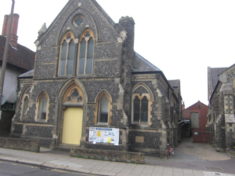
Cowbridge Halls
Cowbridge Halls
Because Cowbridge School was overcrowded, Standard III was using Cowbridge Halls as a classroom. By Monday, 19th October the children were all working back in the school as the halls had been taken over by “the military.” The school was again able to make use of the halls from Thursday, 28th October. In November the military kept demanding use of the halls. They were inclined to turn Standard III out for a half day with little notice. By the end of the month Mr Turpin had decided to move all the school furniture back to the school as the military was likely to want the hall occasionally and presumably without notice. “All the children are now in the school which is again crowded.”
Overnight Accommodation
Some of the schools were used as overnight accommodation by soldiers passing through the town presumably on their way to the south coast and France. This caused the schools to be closed at various times, e.g. Christ Church Infants was occupied until after 10 am on 17th November and Able Smith children were given the whole day off. On the same day, Cowbridge School “closed all day owing to its being necessary as to the floors being so dirty as the N. & S. Staffordshire Territorials passing through the town commandeered the school on Monday night for sleeping in and the school was left unfit.”
In May, 1915 Miss Lethem, Cowbridge recorded attendance suffering because of the number of soldiers passing through the town. The children were obviously distracted by the sights and sounds!
Port Vale Boys’ School
Port Vale Boys’ School
Cowbridge School had been significantly overcrowded for some years and HMIs had threatened to reduce the school stipend.
The HMi report dated 23rd December 1913 states “The accommodation is for 160 elder children and 44 Infants, the present number on the books is 206 elder children and 52 Infants. Some crowding is inevitable till the new school is completed, but the new building is urgently necessary, and should be finished as soon as possible.”
So Port Vale Boys School was opened in April, 1915 (after the Easter holiday) by Alexander Purkis Ginn, Mayor of Hertford. Mr. Walter Turpin moved from Cowbridge to be Master along with his deputy William Coleman. The Hertfordshire Mercury reported the cost as £2,744 4s. 2d., being £119 15s. 10d. less than the estimate sanctioned. This sum was exclusive of the salary of the clerk of works, quantity surveyor’s fees, and litho-graphic expense. There were four teachers at the opening of the school.
Agnes Lethem became Mistress of the Cowbridge Girls’ & Infants’ School.
In his report of 15th May, 1914 on Cowbridge School, HMI Mr. F.S. Martin writes, “It is understood that the new school being built in Hertford will provide accommodation for the boys. The old buildings will then require considerable improvement to make them satisfactory for girls and infants. It may be a question whether the fabric is worth this. Among the alterations needed would be the clearance of the offices, the provision of adequate playground and using the present lobby as a communication corridor.”
The local education authority obviously decided that “the fabric” was worth maintaining as the school was used for various educational purposes until the mid-1960s!
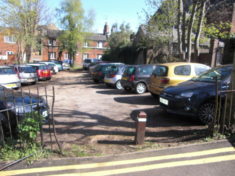
Cowbridge School Playground extension now used as a car park
An extension to the playground was provided. It is now used as a car park!
‘
‘
‘
‘
‘
Temperture of Classrooms
The Factories Act 1937 stated: In every workroom in which a substantial proportion of the work is done sitting and does not involve serious physical effort, a temperature of less than sixty degrees shall not be deemed, after the first hour, to be a reasonable temperature while work is going on, and at least one thermometer shall be provided and maintained in a suitable position in every such workroom.
Bengeo Infant School logbook gives the temperature for most weeks for 1909 until midway through 1916. The chart in note 3 shows during how many weeks the temperature was below 60̊ F. Even this temperature is not very high when you are sitting working!
Air Raids
On evening of Wednesday, 13th October “There was a great calamity in the town,” as Miss Lethem reported in the Cowbridge logbook. This was a Zeppelin raid in which eight men & one boy were killed. Unusually their names are recorded on the Hertford War Memorial in Parliament Square. The incident was not fully reported until January, 1919 because of Government restrictions. The Catholic School logbook reports: “Registers not marked on Thursday (14th) owing to Air Raid of previous night. Several of children’s homes suffered.”
All schools suffered from poor attendance on the Thursday and Friday and into the following week. There were only 139 present out of a total of 224 (62%) on 14th at Abel Smith. Cowbridge had Friday afternoon off as an attendance holiday.4
Among the men killed was James Gregory, 55, who as well as being organist at All Saints’ Church was also a part-time music teacher at Christ Hospital and Hertford Grammar School. He married a teacher at Christ Hospital School.
On 8th April 1916, Marion Porter wrote in the Christ Church logbook, “The attendance was badly affected at the beginning of the week through children being kept up all night during the recent “Zeppelin Raids” over the Country.”
In the week beginning 2nd October, she recorded, “The attendance is very bad today. Several children were taken to the tunnel5 for refuge for several hours during the night whilst Zeppelins were hovering around the district. Children who are present are unfit for regular work.”
On 6th October of the same year the Catholic Schhol logbook records, “Attendance very low owing to Air Raid on Sunday night.”
There were aeroplane raids on 13th & 14th June, 1917 when children were dismissed late morning on the Wednesday, most of the afternoon sessions being cancelled, and mid-afternoon on the Thursday.
Towards the end of September Miss Porter, Christ Church Infants’ complains, “Some parents are beginning to keep their children up at night and take them to the tunnel5 for safety when there is danger of an Air Raid. This is having a bad effect upon their health; as well as making them unfit for work the next day.” Miss Porter makes a similar comment in the first week of October and all the schools suffered poor attendance that week because of air raid warnings. There were further warnings at the end of January & beginning of February, 1917. Some children at Christ Church also had whooping cough so the attendance was down to 54%
On 1st November 1917 Miss Porter again, “The attendance is very poor this morning partly owing to Air Raid Warning. Several children were wakened up and lost their sleep, some who are present are not in working order. The Zeppelin Raid in the Town on the night of October 19th has in some ways upset the School.”
Attendance
Inducements were given to children by the County Council to encourage good attendance. For one to four years full attendance book prizes were given; Certificates or medals for less than 10 absences and watches for full attendance over five years. At the end of 1914 Mr Strubel considered that the sole bright spot of the year at Cowper School was the giving of watches to five boys for perfect attendance.
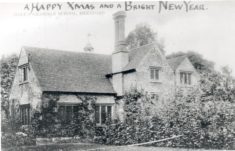
Hertford Grammar School
Hertford Grammar School
The tercentenary of Hertford Grammar School was in 1917 obviously not a happy time. Speech Day began with a solemn service in commemoration of the then 22 old boys6 who had lost theiir lives in the fighting. Their average age was no more than 22. After the Mayor had presented the White Gloves there were some brief references to the founding of the school.
Five masters are recorded as having enlisted during the war and only one did not return. Marcel Coindeau returned with the Croix de Guerre!
The School Certificate was introduced in 1917 candidates were expected to score a mark of 30% or more in five subjects, including one from each of Humanities, Foreign Languages and Maths/Science. HSC for sixth-formers.
Lavatories
Lavatories, or “offices” as they were euphemistically referred to, were outside, usually across the playground from the main building. On 30th March 1914, the HMI Report for the Catholic School commented, “Both rooms ill ventilated & much too dark – 55 in room for 46. cloakroom & offices insufficient. (Proposals for remedying about to be submitted.)”
Christ Chuch Infants appears not to have had any lavatories at all; in the school inspection report of 14th November 1917, H.M.I. Mr. F.S. Marvin reported, “This is a bright little place. Both classes are well taught, and the children happy and attentive. The Managers might well aim at retaining another class in the School. They should bear in mind the need for some Lavatory provision when circumstances permit.”
Empire Day
24th May (Queen Victoria’s birthday) was officially celebrated as Empire Day from 1916. The celebration began in Canada in the late 19th century. It was started in UK in1902 but became more widespread from 1906. The aims were to “remind children that they formed part of the British Empire, and that they might think with others in lands across the sea, what it meant to be sons and daughters of such a glorious Empire.”, and that “The strength of the Empire depended upon them, and they must never forget it.”
Often lessons on the Empire were given, history and geography including such people as Clive of India, General Wolfe of Quebec, General Gordon. Patriotic songs sung and the flag saluted.
In 1916 the children of Christ Church Infants played the “Empire Day Game,” sang and saluted the flag. However, In 1916 children at Cowbridge School could not celebrate the day as the school was closed for a month from 15th May because of three cases of spotted fever7.
1n 1917 at Abel Smith Girls School, “E. D. commemorated by special lessons being given on Duties of Citizenship.”
Children were always given the afternoon off and they were given Friday afternoon off if the 24th occurred over the subsequent weekend!
Losing Children to Work
in February, 1916 Walter Turpin (Port Vale) recorded “The work is going on satisfactorily but gradually the school is losing the best boys over 12 years of age who go off to work, on War Emergency work.”
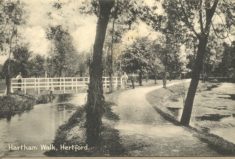
Hartham Walk, 1916
Trips Out
The war and the threat of airship attacks did not stop the children from Cowbridge furthering their education by going out into the neighbourhood, e.g. in 1915 classes went to Hartham to study trees; to Waterford Marsh to examine water plants and visited Molewood. The following summer the senior girls went on a walk to collect medicinal herbs.
Special Efforts
In July 1915, on 14th French Flag day, Cowbridge “a sum of one pound one shilling and 6d was sent up.”
In October, 1915 the week after the Zeppelin Raid, the girls at Cowbridge started “Red Cross Work.”
In February, 1916 the children from Cowbridge went to Port Vale to welcome Corporal Alfred Burt, V.C. an old scholar of the school and presented him with a cigarette case. Burt had been awarded his VC for ripping the fuse out of a German mortar in the trenches thus saving an estimated 20 lives.
Food shortages
In 1917 Germany instigated unrestricted submarine warfare. This made it more difficult to import food and shortages became a big problem. To combat this the population was encouraged to grow more produce. In 1913 Cowper School had been given a plot of land behind the offices of County Medical Officer in Fore Street opposite Christ Hospital. In 1917 the school produced 1025 lb8 of potatoes mostly King Edwards. Also 13 plots (rows) of other vegetables.
The HMI’s report of October 1917 for Cowbridge Girls & Infant School states: “… and the eagerness of the staff and girls to cultivate a small plot of unoccupied land nearby deserves encouragement.”
In September/October 1918 Cowper School was closed for a total of 15 days for blackberrying.9 During this time the boys picked 18 cwt 2 qr 14 lb10 of fruit winning a silver cup presented by Lady Pearson of Brickendonbury, as well as receiving some payment for their efforts. The girls of Abel Smith collected 11 cwt 10 lb11 Children from the other schools were out scouring the countryside for blackberries! The older girls at Cowbridge also went blackberrying at this time but there is no record of how much they collected.
Influenza
Of course the schools were hit by the influenza pandemic of 1918! All schools were affected. No sooner had the boys of Cowper School returned from their blackberrying than the school was closed for more than three weeks because of the flu. Even when it was re-opened some teachers and boys were still affected. Other schools suffered as well. Port Vale Boys’, Cowbridge Girls’ & Infants and Christ Church were all closed for a couple of weeks in October.
Armistice and Peace Celebrations
All the schools were given a half-holiday on 11th or 12th November when word arrived of the signing of the armistice.
The peace celebrations were delayed until July 1919.12 Peace Week began on Monday, 21st July and on the afternoon of Wednesday, 23rd July, all schools held a tea party and games.
Mr. Turpin was impressed with how many boys attended school on the last two days of school before the holiday. “The loyalty of the boys was shown in the excellence of attendance on Thursday & Friday after the treat scarcely a boy being absent.”
In the Catholic School logbook on 24th July, 1919 is recorded ” Visitors: Mayor & Mayoress; ex-mayor Mr. Lacey, Mr. Graveson, Mr. A Thomas, Mr. Barker, Mr. Monk. Tea party in honour of peace. Finished 8:30 pm. Mrs. Warboys provided ice cream.”
Notes:
- Kelly’s Directory of Hertfordshire, 1912.
- Hertfordshire Mercury produced a commemorative booklet on the pageant which along with other sources were used by Philip Sheail in 1914 to produce his booklet, Hertford’s Grand Pageant 1914, ISBN 9780955568428. This booklet is available from hertford Museum.
- Bengeo Infants Heating Data 1915.xls
- In an effort to encourage attendance, children were given an afternoon off if the attendance for the previous month averaged over a certain figure.
- Molewood Tunnel had been completed although the Cuffley to Stevenage extension line had not.
- Hertford Grammar School’s First World War Book of Rembrance records 42 former pupils as killed in action.
- Spotted Fever is an infectious disease brought on by bacteria carried by ticks. In the Hertfordshire Mercury, Saturday, 24th April, 1915 it was describes as being cerebro-spinal fever (meningitis) with the following clinical features: profound disturbance of cerebro-nervous system indicated at onset chiefly by shivering, intense headache or giddiness.
- 9.15 kgm
- The Government requested schools throughout the country to organise their children to collect blackberries during school time. The blackberries were sent to local centres where apple and blackberry jam was made and sent to the troops. Some blackberries may have been made into juice which is high in vitamins and fibre. There were also reports of blackberry vinegar being produced. This could be taken with hot water to ease a head cold.
- Nearly 950 kgm
- Approximately 560 kgm
- The peace treaty with Germany was signed on 28th June, 1919 (ironically exactly five years to the day that Achduke Franz Ferdinand was assassinated in Sarajevo.)


Add your comment about this page